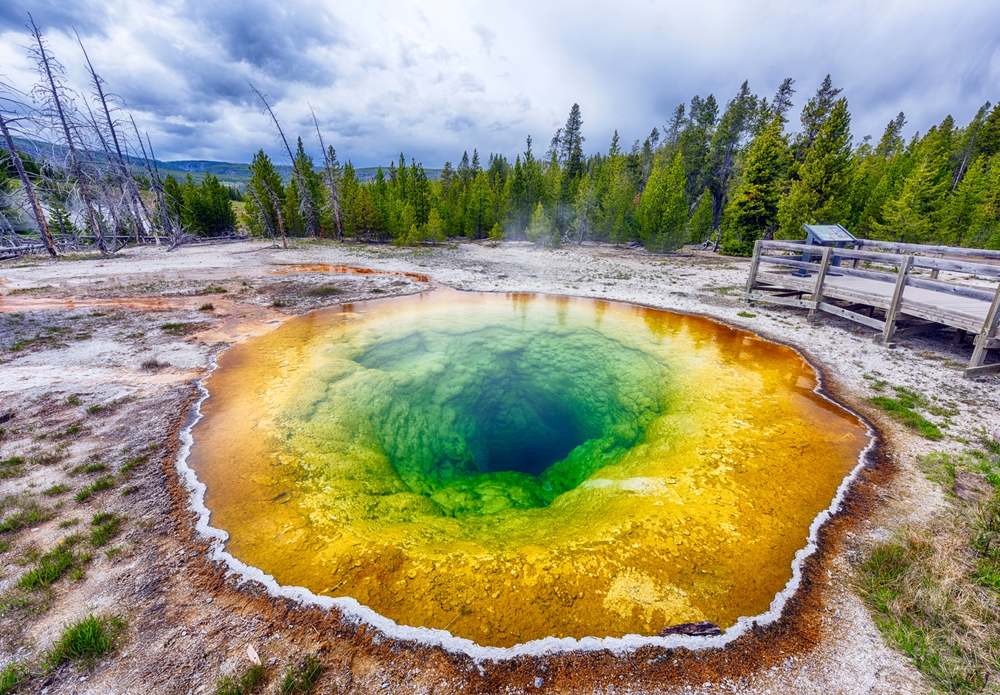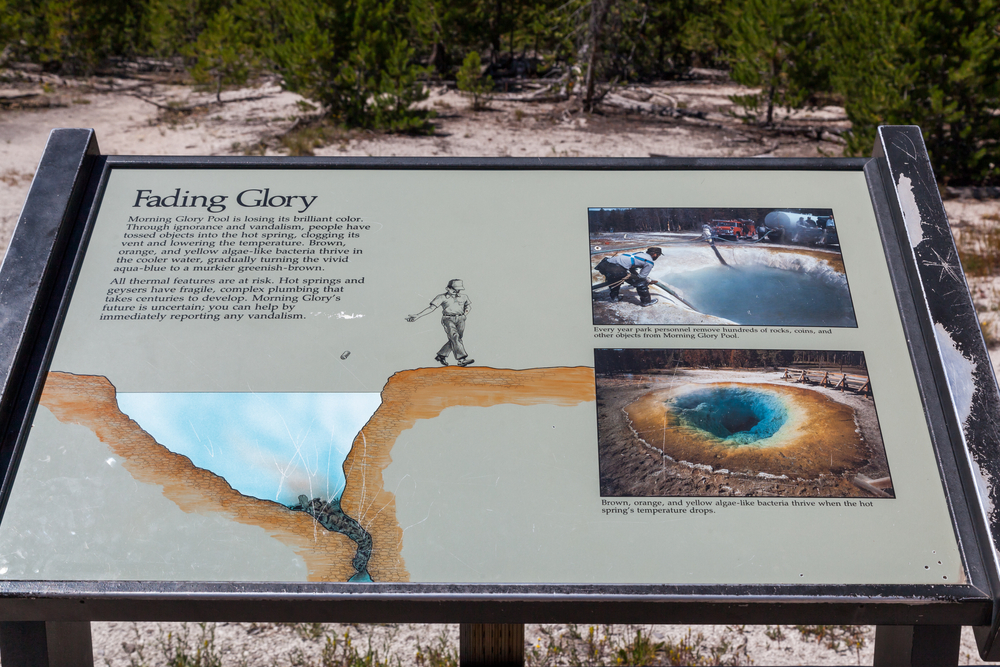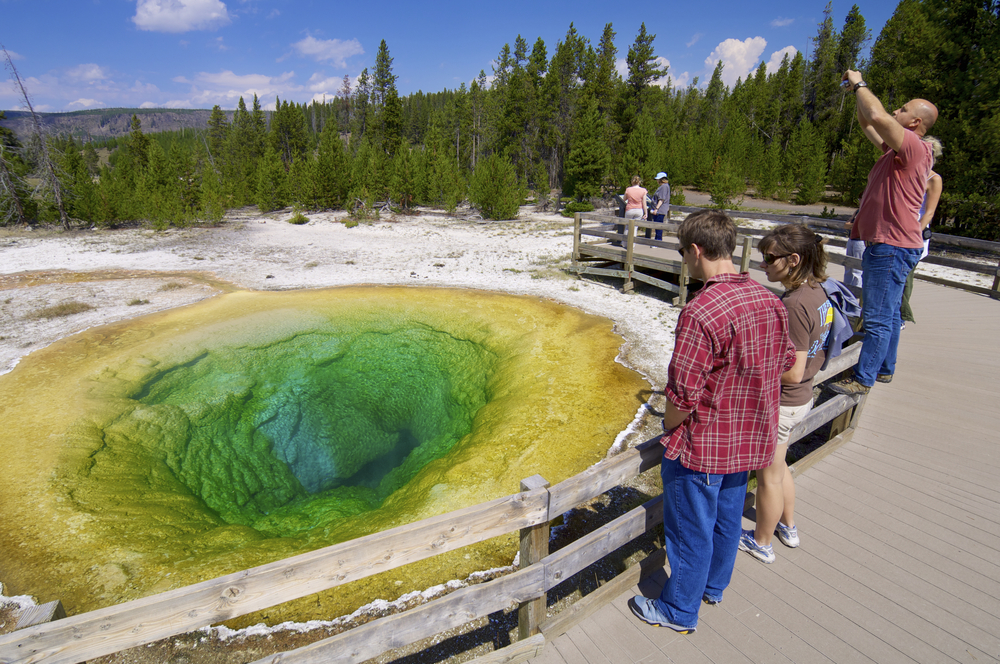The Morning Glory Pool is one of the most beautiful attractions in the already fabulous Yellowstone National Park but it’s also been one of the more rapidly changing features in the park. Far from its original deep blue color, giving it the original name, in recent years it’s taken on different tones.
So, let’s take a closer look at how the Morning Glory Pool was formed and what’s causing the color-changing phenomenon today!
Discovery of Morning Glory Pool
The Morning Glory Pool was discovered in Yellowstone, or at least given it’s own name, in 1883. Yellowstone itself is one of the few hotbeds of geothermal activity across the planet, where the network of magma and cracks sit relatively shallow and create a wide variety of different, dynamic terrain features like hot springs and geysers.
The namesake plant of the pool is a simple, blue flower that grows on vines. It’s mainly known for the deep blue that makes it up, and the shape of the pool helps a bit as well. At least for those familiar with the various Ipomoea species. You can look into the pool and see the deep parts which angle outward at the surface, similar to the petals of the namesake plant.
Today, the pool is mainly known for being deep green with an ochre color coming in from the edges. It’s an impressive effect, a gradient of brilliant colors across the round pool, but it’s not quite the same. Older pictures can still be found, where the pool was a deep blue with high transparency, similar to tropical ocean waters.
Those familiar with Yellowstone are aware of the tendency for mats of yellow and orange coloration that often emerge around the various hot springs in the park. These are actually comprised of bacteria, and they often get into the water.
These thermophilic (heat-loving) bacteria are an example of extremophilic organisms which require conditions that are generally outside of what we’d consider the “acceptable” range for life.
In this case, the original Morning Glory Pool was actually so hot that it prevented these heat-loving microorganisms from forming. With a constant upswelling of hot water from the ground below, the water remained clear and blue.
But eventually, that changed.
Fading With Time

Over time, the pool began to show color changes. While there is no constant coloration the general outline is the same these days. The once robin-egg blue pool is now tinged with various shades of orange and yellow around the edges, while the center is often much closer to green in color.
In some ways, it’s almost more impressive these days than it used to be but the cause of the change in the Morning Glory Pool’s change of coloration isn’t nearly as benign as we’d like.
But the fact of the matter is that it has changed in color as lower temperatures have allowed thermophilic bacteria to thrive throughout the pool. The reason for the changing colors as the pool reaches its center is also relatively simple.
While many of Yellowstone’s extremophile bacteria exist only in certain temperature ranges, the actual gradient of color is simply produced by the effect of deeper water on sunlight. The bacterial mats created in the water change hue as they get into deeper water due to the changing dispersion of light in the deeper water.
This is the same reason for the original blue gradient that was found in the pool, just with the addition of the color of the bacterial mats. Likewise, the different bacteria prefer different temperature ranges and these can be quite narrow which contributes to the smooth gradient of color of the pool itself.
Older pictures clearly show the changing beauty of the pool. Pictures from as recent as 1940, however, show some level of yellowing around the edges of the pool. While this can be attributed to simple drops in temperature, compared to the pool at its height, it’s actually caused entirely by humans and not a natural effect of cooling geothermal activity.
Human Effect on the Morning Glory Pool

Humans are odd creatures, and we do some trippy stuff. One of the things that people tend to do is… chuck things into bodies of water. The more interesting, and seemingly deep, the better.
Unfortunately, this is also the cause of the cooling of the pool.
The hydrothermal pools in Yellowstone are fed by an intricate “plumbing” of cracks caused by geothermal and tectonic activity underground. In many places in Yellowstone, you may only be standing a bare 3-8 miles over the local magma.
While the structure was kind of guessed at, recent efforts provide a more complete picture. Most of the hot water features of the region are directly over faults and fractures deep in the Earth. These “pipes” are what provide the heat that feeds the hot springs, geysers, and other geothermal phenomenon that lies beneath the earth.
These can bottleneck or expand, causing things like outgassing or boiling in the water that was previously under less pressure as it rose.
Meanwhile, horizontal features appear to feed cooler water into the system.
Chucking a penny or a rock into a single spring is unlikely to produce any significant blockage. The problem is that it’s not just one goofy individual tossing things in, it’s dozens of tourists per year over more than a century. This has created blockages in the plumbing which feeds into the spring. Combined with the relatively shallow fractures bringing along cooler water, the overall effect on Morning Glory Pool is obvious.

We chucked so much trash into this glorious natural feature that we’ve changed the rates at which hot and cold water flow into it. Essentially, tourists dropped debris into the pool until it caused a blockage.
The end result?
Morning Glory Pool has gone from being so hot and pure that it was a deep blue, relatively bacteria-free environment to the mottled colors we see today. Currently, the pool fades from yellow to orange, to green as you get to the deeper portions of the pool.
No one seems to have an answer on whether or not it’s feasible to begin clearing the blockage that remains beneath the pool itself. While theoretically possible, it’s not quite as easy as just having someone dive down and pull things up.
After all, Morning Glory Pool still averages roughly 160°F (71°C), which makes it a far more challenging task than simple debris retrieval. Some efforts have been made, including a drive in 1972, to remove debris from the pool but they haven’t been successful.
So, for the time being, its best to just enjoy the odd colors and avoid contributing to the problem.
Sadly, this isn’t the only pool to suffer a decline in Yellowstone. It’s simply the most dramatic. While I’m all for visiting natural areas, I probably interact more than I should with many
features, it’s up to all of us to prevent these kinds of things from continuing to happen.
Part of that is reporting any vandalism you see take place in the park. The hotline number is 307-344-2132.
So, we may never be able to restore this beautiful part of nature but we can all band together to prevent future damage.

